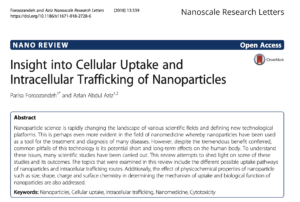This is a summary and explanation of the following research paper:
Insight into Cellular Uptake and Intracellular Trafficking of Nanoparticles
- Published: Online > Nanoscale Research Letters
- On: Oct 25, 2018

Key Takeaways for Relation of Nanoparticle Size to Cellular Update
- The paper summarizes: “Several studies have indicated that for cellular uptake of NPs, there is an optimum size of 50 nm at which NPs are internalized more efficiently and has a higher uptake rate. NP uptake was shown to decrease for smaller particles (about 15–30 nm) or larger particles (about 70–240 nm)”
- The context in this paper is in understanding optimal nanoparticle size for uptake in biomedical applications.
- It’s clear that cells can uptake nanoparticles from 15 nm to 240 nm. It’s possible that particles outside these sizes can still enter cells.
Review Summary
This paper is a review on research to date on the cellular uptake and intracellular trafficking of nanoparticles. In regards to plastic particles it can help us understand what size of particles may be able to pass through cell membranes, into cells, and between cells.
Here is a summary of the main points from this paper:
- Cellular uptake pathways of nanoparticles: Nanoparticles can enter cells via various endocytotic pathways such as clathrin-mediated endocytosis, caveolae-mediated endocytosis, macropinocytosis, etc. The uptake pathway is determined by factors like nanoparticle size, shape, surface charge, hydrophobicity, etc.
- Intracellular trafficking of nanoparticles: Once internalized, nanoparticles are transported within membrane-bound vesicles (endosomes) which fuse with lysosomes where the particles can be degraded. However, some nanoparticles escape this pathway and are released into the cytoplasm.
- Effect of nanoparticle properties on uptake: Size is a key factor, with an optimal size of around 50 nm for efficient uptake. Shape also affects uptake, with spherical nanoparticles showing higher internalization. Positively charged nanoparticles have higher uptake due to interaction with the negatively charged cell membrane. Surface hydrophobicity also increases nanoparticle-cell membrane interactions and uptake.
- Applications in nanomedicine: Understanding the cellular interactions and intracellular fate of nanoparticles is crucial for designing safe and effective nanoparticle-based drug delivery systems, imaging agents, etc. Modulating nanoparticle characteristics can help target specific cell types and intracellular compartments.
